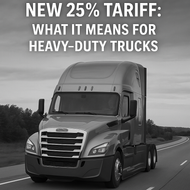New Tariffs on Heavy-Duty Trucks: What They Mean for Freightliner and the Industry

The U.S. trucking industry is facing a major shake-up. On October 1, 2025, a new 25% tariff on imported heavy-duty trucks will take effect, reshaping costs for fleets, manufacturers, and suppliers alike. For companies like Freightliner, one of America’s most recognized heavy-truck brands, the tariff creates both challenges and opportunities.
What the Tariff Covers
Scope: All heavy-duty truck imports will face a 25% duty.
Previous Rate: 0% — meaning this is a direct cost shock.
Uncertainty: It’s still unclear whether trucks and parts from Canada and Mexico (under USMCA) will be exempt. Many U.S. trucks are built or partially assembled in Mexico, so the ruling is critical.
How Costs Will Change
For fleets, the tariff could raise truck prices by nearly 9%. With the existing 12% federal excise tax (FET) stacked on top, the price of a new Class 8 tractor could climb to $240,000 or more.
This cost increase will likely ripple into:
Truck financing – higher upfront costs and bigger loan amounts.
Fleet planning – some buyers may rush orders before tariffs hit.
Used trucks – higher demand as fleets look for cheaper alternatives.
What It Means for Freightliner
 Freightliner, part of Daimler Truck North America, has a strong U.S. manufacturing base. That could give it an edge over foreign competitors who rely heavily on imports. However, there are still risks:
Freightliner, part of Daimler Truck North America, has a strong U.S. manufacturing base. That could give it an edge over foreign competitors who rely heavily on imports. However, there are still risks:
Parts & Components – Many Freightliner parts come from international suppliers. If components are hit, costs rise even for U.S.-built trucks.
Supply Chain Pressure – More localized sourcing may be needed, which could disrupt production.
Dealer Demand – Orders could spike short-term but soften later as higher prices settle in.
In short, Freightliner could win market share, but margins may tighten if costs can’t be fully passed on to buyers.
The Ripple Effect on Truck Parts
At Duaparts, we know these policy shifts affect more than just new truck sales:
Imported components may see price hikes.
Maintenance budgets will need to adjust.
Fleet managers will look for reliable aftermarket alternatives to manage costs.
This is where aftermarket parts suppliers like us step in. By offering trusted, affordable parts and keeping a close eye on supply chains, we help customers stay ahead of rising costs.
The new tariff marks a turning point for the trucking industry. While it creates uncertainty, it also highlights the importance of strong domestic brands like Freightliner and the aftermarket parts network that keeps fleets rolling.
At Duaparts, we’ll continue tracking these changes to help our customers find the best parts at the best prices, no matter how the market shifts.

